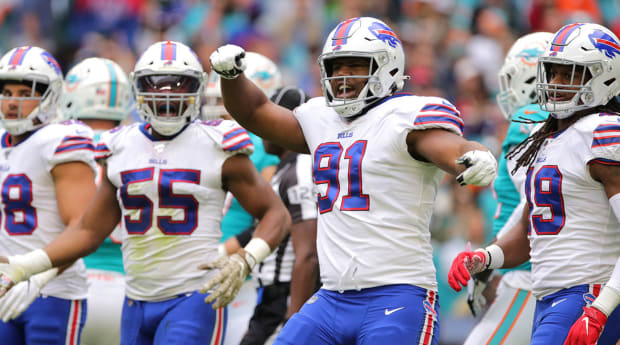The Bills’ four-year, $68 million deal with DT Ed Oliver provides all of us with a great lesson on positional value in today’s NFL. The contract itself isn’t dissimilar from the one that Oliver’s fellow former Buffalo first-rounder Tremaine Edmunds just did in Chicago (he signed for $72 million over four years) and that, on Saturday, raised obvious questions, since Edmunds has been the splashier, more visible player over the past few years.
The answer is sitting on the Bills’ cap table. Their six highest-paid players, in order and by APY, are as follows: a quarterback, a receiver, an edge rusher, a corner, (now) a pass-rushing 3-technique defensive tackle and a left tackle. After that, you get an off-ball linebacker, in Matt Milano, who came in at a more affordable price than Edmunds; a tight end; a safety; and a center.
The bottom line in all of it is that this is how teams that have tough choices to make do it now.
Four of the six aforementioned millionaires were drafted and developed in Buffalo; another was traded for and extended; another was a big-ticket free-agent signing. As those players’ financial numbers have grown or have been added to the books, cap space has gotten tighter and decisions have had to be made. And like a lot of teams have, the Bills have prioritized premium positions as they’ve adjusted to the bulge atop their cap.

Sam Navarro/USA TODAY Sports
So how did Oliver wind up making the cut despite having just 14.5 career sacks and never more than five in a season? This is how …
• When the Bills looked at the advanced statistics, they found their defense, and specifically their pass rush, was significantly more effective with Oliver on the field than it was without him. Part of Oliver’s lack of sack production is because he isn’t tall and long, so it’s hard for him to finish on the quarterback—but he’s moving the passer off his spot, and in doing so helping others get him on the ground.
• Buffalo thought Oliver was on the verge of having a breakthrough year after the camp he had last summer. But he suffered a high-ankle sprain in the first half of the kickoff game against the Rams and really wasn’t the same the rest of the year, even though he was back in the lineup for Week 5. He’s told people he didn’t feel like himself again until March.
• The contract itself is more reasonable than you think. He’s making $17 million per year, which puts him 13th among defensive tackles. He’ll probably be 15th by the time the season starts, with two other 3-techniques (the Jets’ Quinnen Williams and the Dolphins’ Christian Wilkins) likely to get blockbuster extensions soon.
• The context, for now, would be that Oliver got a little less than new Seahawk Dre’Mont Jones (three years, $51 million). Also, as far as scarcity goes, the Bills figured if you put Oliver in this year’s draft, as he was coming out, he would have been the second-best DT behind Jalen Carter. And the chances of the Bills’ being in position to get such a player that high in the draft soon aren’t great.
And for what it’s worth, while the Bills are cutting Oliver’s cap number (previously set at $10.75 million) in half with the new contract, I don’t think it changes much on DeAndre Hopkins for them. It would still take Hopkins’s accepting a serious discount for Buffalo to consider circling back. Hopkins’s monetary ask, which escalated after Odell Beckham Jr. signed in April, was too rich for the Bills’ blood then (as was the case with the similarly interested Chiefs).







